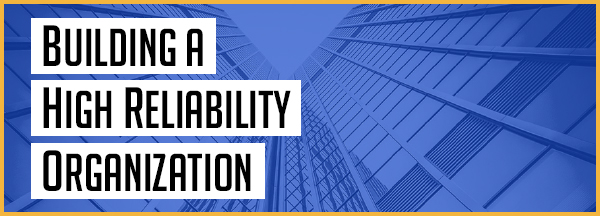What is a High Reliability Organization?

What might be the ultimate risk management machine, is called a ‘High Reliability Organization’ (HRO). HRO can be thought of as a very advanced version of continuous quality improvement that extends to the performance of an entire organization.
Two of the leading researchers on HROs define it like this:
High-reliability organizations operate under challenging conditions yet experience fewer problems than would be anticipated as they have developed ways of “managing the unexpected” better than most organizations. (from Managing the Unexpected: Sustained Performance in a Complex World, K.E. Weick and K.M. Sutcliffe)
Weick and Sutcliffe’s book title points to some important characteristics of HROs:
- HROs manage unexpected risks successfully. They go beyond traditional risk management practices in which internal and external risks are identified and controls are built to mitigate them. Instead, they create a culture and workforce that respond to threats dynamically.
- The high-quality performance of HROs is sustained across time, allowing the organization to adapt to changing conditions. The HRO is a learning organization.
- HROs evolve in very complex environments—they develop techniques and human capacities in response to challenging circumstances that would degrade the performance of less capable organizations.
- HROs focus tightly on the outcomes that define the mission of the organization. In this sense, they are mission driven.
The concept of HROs emerged from the study of organizations that had to deliver specific outcomes reliably despite being in very risky, complex environments. The aircraft carrier, the commercial air traffic system, and nuclear power plants have been among organizations studied for their ability to deliver high reliability and safety when failures could be catastrophic. A graphic description of the aircraft carrier is a good case in point:
So, you want to understand an aircraft carrier? Well, just imagine that it’s a busy day, and you shrink San Francisco Airport to only one short runway and one ramp and one gate. Make planes take off and land at the same time, at half the present time interval, rock the runway from side to side, and require that everyone who leaves in the morning returns that same day. Make sure the equipment is so close to the edge of the envelope that it’s fragile. Then turn off the radar to avoid detection, impose strict controls on radios, fuel the aircraft in place with their engines running, put an enemy in the air, and scatter live bombs and rockets around. Now wet the whole thing down with seawater and oil, and man it with 20-year-olds, half of whom have never seen an airplane up-close. Oh, and by the way, try not to kill anyone. — Senior officer, Air Division (Naval War College Review, 1987)
Today, managers and researchers are extending the concept to organizations that are not quite as “heroic” as aircraft carriers and nuclear plants. Many healthcare systems and hospitals are looking at HRO characteristics to improve patient outcomes, specifically unnecessary deaths and hospital-induced diseases. Other complex systems such as cash management or power grid operations might benefit from the application of these principles to the outcomes they desire.
For more information about HROs and how the concept might apply to your organization, download a copy of our newest whitepaper, Building a High Reliability Organization.